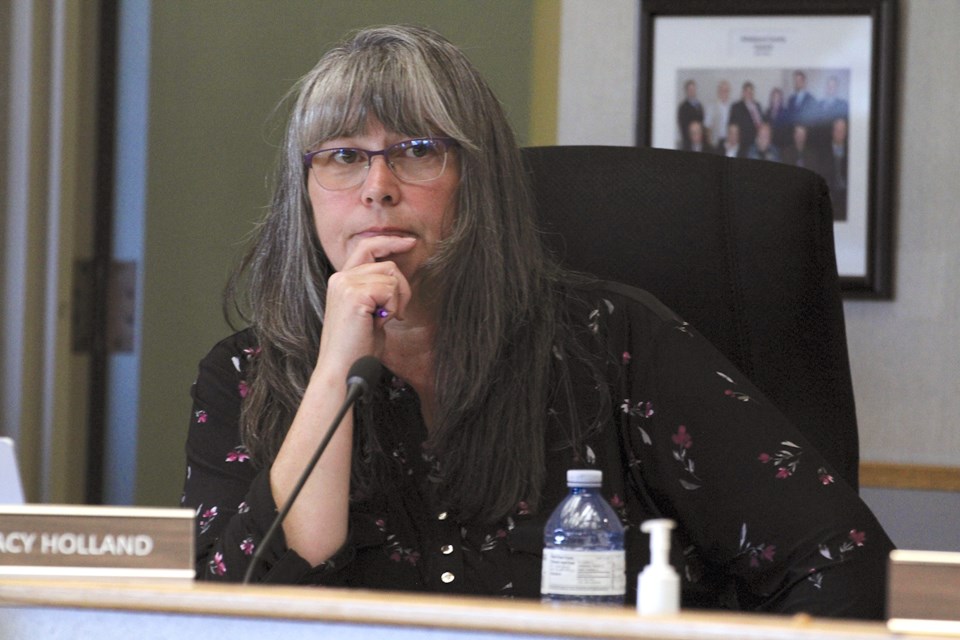ATHABASCA – Athabasca County councillors failed to reach anything approaching a consensus during a discussion around ratepayer water rates, with the room splitting into two factions early in the discussion and remaining that way throughout.
During the Nov. 19 committee of the whole (CotW) meeting, councillors voted 4-3 in favour of a motion to investigate the possibility of cancelling the Colinton water levy bylaw after a mixed discussion that saw many questions asked with few answers.
Reeve Tracy Holland and councillors Rob Minns, Kelly Chamzuk, and Gary Cromwell were in favour of the motion, while councillors Brian Hall, Ashtin Anderson, and Camille Wallach were opposed. Councillors Joe Gerlach and Natasha Kapitaniuk were absent.
The discussion got started thanks to an administrative report on the varying water rates across Athabasca County — a delegation at the October CotW meeting had asked councillors to reconsider rates, citing research that showed Athabasca County had the highest costs in the region. Holland put forward a number of changes she wanted to see in the policy, which included large-scale changes to how the county charges residents for water.
“I would like to remove the levy in Colinton, lower the minimum cubes to four from 10 and base our costs on previous years actual costs,” said Holland. “I don’t recall us aiming to have a surplus from our water supply, so I would like to see us take the surplus from 2023 actually be moved to the water capital reserve for equipment and lines there.”
Thanks to Colinton’s annual $232 local improvement levy — a type of land-based tax where a fee is applied to each property to help pay for an infrastructure improvement — different regions in Athabasca County pay different rates for water, at least initially.
According to documents presented in the committee’s agenda package, Colinton pays the Athabasca Regional Water Services Commission (ARWSC) rate plus $3.20 per cubic metre, up to 10 cubes. After the initial ten cubes — which everyone is charged under the minimum usage fee — Colinton’s rate rises to $5.13 per cube. Grassland and Wandering River pay ARWSC’s rate plus $5.13, regardless of how much water is used.
Grassland and Wandering River were not charged a local improvement levy when the waterline was expanded into the communities, and because of that, Colinton’s levy is cancelled out by the subsidized water rate. Each community pays the same amounts for water, but it doesn’t appear that way at first glance, as councillors pointed out.
“Removing the levy is something we can do — I would like to make things fair across the board. We can standardize across the board, we’ve been talking about it forever to make water fair and equitable for everybody, no matter where you reside,” said Cromwell.
“We shouldn’t punish some and reward others based on how close you are to urban.”
Previously, communities paid more for water the further away from Athabasca they were, but ARWSC changed its rates effective 2023 to help equalize water usage across the board. Now, each municipality, including the town as of 2025, will pay the same flat rate for water.
“We’re zeroing out the levy to begin with, so to me it makes zero sense that we are charging it and then zeroing it out,” said Holland. “If we are able to remove it, it makes it cleaner and we’re done dealing with it.”
Because of how the levy is structured — Colinton was given the option of paying it out all at once, or in a small fee year-by-year — councillors weren’t sure if they would be able to remove it without paying out residents. In response to a question from Wallach, who asked, ‘Is this even legal?” CAO Bob Beck said he would have to look into it.
“We would have to look into the implications of it. I’ve got to be honest, I’ve never heard of a local improvement levy being paid out. It’s not to say it hasn’t been done, but it’s one thing I’ve never seen before,” said Beck.
Who pays for water?
Beyond the Colinton levy, councillors also grappled with how much, if at all, water should be subsidized by the municipality.
Currently, residents pay a flat rate of 10 cubic metres a month, plus any extra used. As Holland pointed out, that flat rate can be punitive for certain demographics, including the county’s seniors, who rarely would use that amount of water.
“I haul water for myself and my wife, and we go through anywhere from five to six cubes a month. I’m okay with five or six (cubes) because I know how much we use. If we drop the minimum, we could drop the rate a bit,” said Minns.
Other councillors pointed out that lowering the minimum usage would subsidize industry instead of seniors.
“I’m okay with the idea of making a statement and saying, ‘We’re okay with subsidizing water for our residents,’ but I think it has to be based on research and facts,” said Coun. Hall. “We have to have a conversation still about to what extent we are prepared to subsidize industry.”
Hall suggested a method where the first six cubes are provided at a bargain, and extra cubes are charged at a cost recovery rate.
“I think there’s a way to thread the needle here where we make a difference for ratepayers and affordability, but don’t go crazy on the industrial side.”


